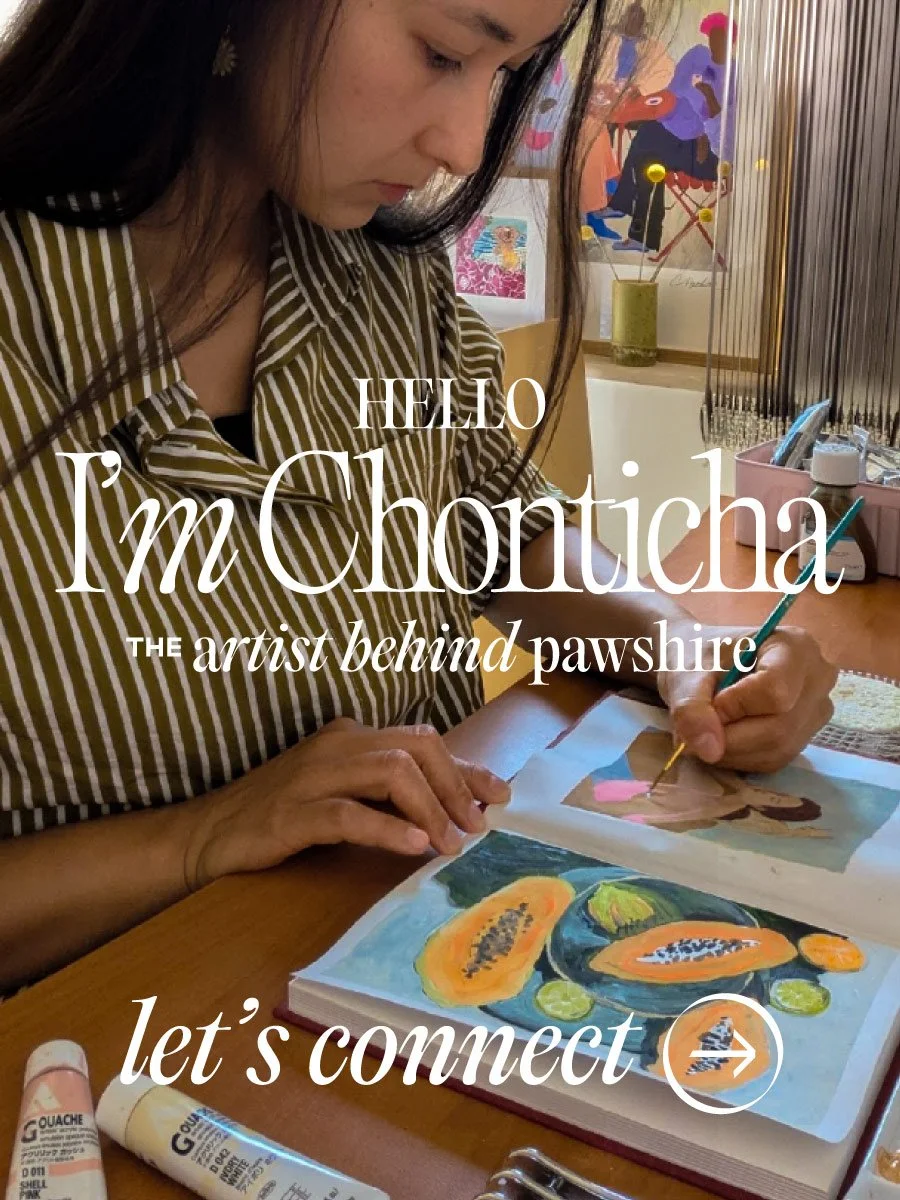The simplest way to find your own art style | Advice from an Artist
Welcome to Pawshire. I'm Chonticha, a painter who works mostly in gouache, and whenever I travel, I visit art stores like they’re temples. I don’t go in looking for fancy tools… I go in to feel inspired. The colors, the packaging, the quietness of each aisle… it’s all part of how I find ideas for my next piece.
For the video version of this post, watch below.
LATEST WORKS & SHOP UPDATES ON INSTAGRAM
“I want to find my own art style, what should I do?”
If you’re asking you’re self this question, I hope you’ll find some inspiring answers here!
For a long time, I struggled with finding my art style. I even stopped drawing altogether, convinced I wasn’t good enough. I’d scroll through Instagram or Pinterest, see other artists’ work, and think, “Why doesn’t my art look like that?” Every sketch felt disconnected and disappointing.
That frustration slowly turned into self-doubt, and eventually, I gave up drawing for myself. After years of working as a graphic designer and rarely creating outside of client projects, the blank page started to feel intimidating. I missed drawing just for the joy of it—but that joy felt far away.
So, how do you find your own art style?
Today, I know one simple truth: your art style shows up when you consistently draw what you love. That’s it. It’s not rocket science. You don’t need to master every technique or medium. You don’t need to wait until your skills feel “good enough.” You just need to keep coming back to the page—with intention, and with care.
Your style is not something you invent. It’s something you uncover. It’s already there, shaped by your personality, your quirks, your taste, your experiences, and the things you feel drawn to again and again.
Why this approach works
Every time you draw something you genuinely enjoy, you're making choices—about colors, shapes, subjects, even composition. And those choices say a lot about who you are as an artist. The more you draw from that space of joy and curiosity, the clearer your style becomes.
It doesn’t matter if it’s a messy sketch. It doesn’t matter if you only have five minutes. Drawing regularly, even for 30 seconds a day, creates a habit that helps you tune into your preferences and creative voice.
A quiet shift: from stuck to steady
This daily act—of drawing something small that sparks joy—helped me move from overwhelm to momentum. I stopped trying to copy the “perfect” styles I saw online. I started trusting my instincts. Slowly, the pieces started connecting. The blank page became less scary, and drawing felt playful again.
8 Practical Tips to Find Your Own Art Style (That Actually Work)
As part of your artistic style exploration, the practical tips below should be able to help you explore without feeling overwhelmed or discouraged. These are easy steps you can take right now to discover your unique artistic voice:
Observe your daily life:
Find what naturally catches your attention. Sketch those things. Your style is hidden in your daily routine and personal interests.Experiment with different mediums:
Test various supplies. Gouache, markers, pencils, pastels—see what feels best to express yourself. Every medium teaches you something new about yourself.Create stories around your subjects:
Add context or imagine backstories. If you’re drawing a cat, what’s it doing? What's its owner thinking? This helps add depth to your art and clarify your perspective.Use colors you genuinely love:
Experiment with colors and don’t worry about rules. If you’re scared of using too many colors, choose three hues you love, then play with lighter and darker shades of these colors. Color should always reflect your personal taste.Loosen up your hand and your mindset:
Don't focus on perfectionism. Embrace spontaneity. Mistakes can teach you faster than perfectly controlled practice.Study artists you admire (but don't copy blindly):
Recreate artworks from artists you love to understand their techniques. But remember, the goal isn’t imitation; it’s about integrating valuable insights into your personal way of expression.Disconnect from social media once in a while:
Social media can be overwhelming. Take breaks from external inspiration to hear your own creative voice clearly.Embrace mistakes (seriously!):
Mistakes help you grow faster than perfect drawings ever will. Allow imperfections and experiment freely—it's how you'll discover your real strengths.Be patient and kind to yourself:
Finding your style isn’t about reaching a destination. It’s a journey, often messy and nonlinear. Let go of perfection and enjoy the process.
Final Thoughts on Finding Your Art Style
A gentle reminder: your art style isn’t fixed. It shifts and grows with you.
The real key is staying consistent, staying curious, and staying open. Keep drawing what you love, even on the days it feels hard. Trust that with time, your unique creative voice will become clearer—because it’s already within you.
I hope this encourages you to keep creating, especially when it feels like nothing is working. Your art matters. Your perspective matters. Just show up, and let your style unfold through the process.
You're already on the right path. Keep going.
From a sketch to the final painting - Pawshire©
Summary: how to find your own art style
It was a rather long rant on how to find your own art style. So here is a practical summary of the approach.
Find your art style by drawing one of the things you love every single day.
Drawing each day not only hones your skills but also ingrains drawing into your identity. You do, therefore you are.
Focus on drawing what you love (it can be one thing, or a few more, doesn’t matter). Through this process, you'll refine your understanding of yourself, tackling mistakes and evolving in alignment with your own world-view. This self-exploration will clarify your identity and help you to make artistic decisions with confidence.










